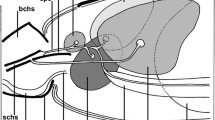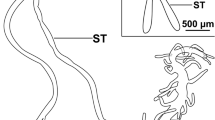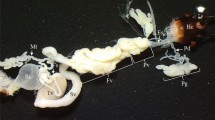Abstract
Autoradiographic studies using 3H uridine in the salivary glands of three bugs, Lethocerus indicus, Laccotrephes rubra and Antilochus coqueberti show that the nuclei play an important role in contributing RNA. The labelled materials are seen to move into the lumen from the epithelia. RNA shows a tendency to accumulate in the lumen with ascending incubation periods. This behaviour in conjunction with its nucleolar genesis indicates its nature as rRNA. It is also believed that RNA might conjugate with some of the protein available in the lumen to produce RNP.
Résumé
Desetudes autoradiographiques des glandes salivaires de 3 espèces de punaises, Lethocerus indicus, Laccotrephes rubra et Antilochus coqueberti, a l’aide de l’uridine radioactive (3H) montrent que les nuclei jouent un rôle primordial dans la synthèse de l’ARN. Le matériel radioactif semble se déplacer de i’épithélium vers la lumière. L’ ARN montrerait une tendance à s’accumuler dans la lumière au fur et à mesure que se prolongent les périodes d’incubation. Ce fait, en conjonction avec l’origine nucléique de l’ARN confirme que l’ARN en question ici est d’origine ribosomal. On suppose aussi que l’ARN se combinerait avec certaines protéines présentes dans la lumière pour former des PRN.
Similar content being viewed by others
References
Akai H. and Kobayashi M. (1965a) Site of the fibroin formation in the silk glands of Bombyx morì. Nature 206, 529.
Akai H. and Kobayashi M.(1965b) Incorporation of the labelled thymidine into the silk glands of the silkworm. Nature 206, 847–848.
Beams H. and Sekhon S. (1966) Morphological studies on the secretion in the silk glands of the caddish fly larvae, Platyphalyx designatus. Z. Zellforsh 72, 408–414.
Berry S. J. (1985) RNA synthesis and storage during insect oogenesis. In Developmental Biology. A Comprehensive Synthesis Vol. 1 Oogenesis (Edited by Browder L. W.), Plenum Press, N. York.
Bier K.(1963) Synthese, interzellularev Transport und Abbu von Ribonucleinsaure in Ovar der Stubenfliege Musca domestica. J. Cell Biol. 16, 436-440.
Capco D. and Jeffery W., (1979) Origin and special distribution of maternal mRNA during oogenesis of an insect Oncopeltus fasciatus. J. Cell Sci. 39, 63–76.
Cave M.D. (1973) Synthesis and characterisation of amplified DNA oocytes of the house cricket, Achaeta domesticus (Orthoptera: Gyrillaidae). Chromosoma 42, 1–22.
Gundevia H.S (1985) Autoradiographic studies on RNA synthesis and transport in the ovary of Hydrophylus olivaceus (Coleoptera). Experientia 41, 383–385.
Gundevia H.S. (1989) Studies on the RNA synthesis and transport in the corpora aliata of Hydrophylus olivaceus Fabr. (Coleoptera). Zool. Jb. Physiol. 93, 347–352.
Haridass E.T, and Ananthakrishnan T. N. (1981) Functional morphology of the salivary system in some Reduviidae (Insecta:Heteroptera), Proc. Indian Acad. Sci. (Anim. Sci.) 90, 145–160.
Jacob J. (1967) An electron microscopic autoradiographic study of the site of initial synthesis of RNA in the nucleolus of Smittia. Exp. Cell Res. 48, 276–282.
Jebanesan A., Thatheyus A. J. and Selvanayagam M. (1988) Mosquito control by aquatic hemipterans in river Cooum, Madras. Bicovas 1, 203–211.
Jayachandra C. M. and Venkatesan P. (1988) Predatory efficiency of giant water bug, Lethocerus indiens Lep & Serv (Hemiptera:Be-lostomatidae: Lethocerinae). Bicovas 1, 13–26.
King R.C. and Burnett R. G. (1959) Autoradiographic studies of uptake of tritiated glycine, thymidine and uridine by fruit fly ovaries. Science 19, 1674–1675.
Kumar D. (1978) Histophysiological studies of the salivary apparatus of Indian Hemiptera: Morphological, histological, histochemical, autoradiographic and electron microscopic investigations. Ph.D. thesis, BHU,Varanasi, India.
Miles P.W. (1972) The saliva of Hemiptera. Adv. Insect Physiol. 9, 183–225.
Miller N.C.E.(1971) The Biology of the Heteroptera. Second (revised) edition, Hampton (England). E. W. Classey.
Muhlach W. E. and Schwalm F. E. (1977) Utilisation of uridine in developing ovarioles of the kelp fly, Coelopa. J. Insect Physiol. 23, 931–937.
Nummelin M. (1988) Water striders (Het: Gerridae) as predators of hatching mosquitoes. Bicovas 1, 121–125.
Ramamurty P.S. (1963) Uberdie Horkunft der Ribonulkeinsaure in den wachsenden Eizellen der Skorpionsfliege, Panorpa communis. Naturwischft 50, 383–384.
Ray A. (1979) Autoradiographic studies on RNA synthesis in trophophocytes and germinal vesicles of Menochilus sexmaculatus (Coleoptera: Coccinellidae). Entomon 4, 1–5.
Ray A. and Ramamurty P. S. (1979) Sources of RNA supply to the oocytes in Crynodes peregrinus F. (Coleoptera: Chrysomelidae) Int. J. Insect Morphol. Embryol. 8, 113–122.
Sirlin J. L. and Jacob J. (1964) Sequential and reversible inhibition of synthesis of RNA in the nucleolus and chromosomes. Effect of benzamide and substituted benzamiadozoles on dipteran salivary glands. Nature 204, 545–547.
Takeda N. (1976) Activatory mechanisms of the prothoracic glands of Monema flavescens (Lepidoptera) with special reference to the secretion of ecdysone. Biol. Bull. 150, 500–521.
Wiley M. J. and Lai-Fook J. (1974) Studies on the silk glands of Calpodesethlius Stall. (Lepidoptera:Hersperudae). J. Morphol. 144, 297–322.
Yadav P. R. (1988) Studies on the salivary apparatus and saliva of some Hemiptera. Ph.D. thesis, BHU,Varanasi, India.
Yadav P.R. (1990) Morphological, histological and histochemical observation on the salivary glands of Ranatrafiliformis Fabr (Heteroptera). J. Zool. Res. 3, 89–99.
Yadav P. R. (1992) Protein synthesis in the salivary glands of some bugs: An autoradiographic study of 3H glycine incorporation. Insect Sci. Applic. 13, 49–58.
Zalokar M.(1960) Sites of ribonucleic acid and protein synthesis in Drosophila. Exp.Cell Res. 19, 184–196.
Author information
Authors and Affiliations
Rights and permissions
About this article
Cite this article
Yadav, P.R., Kumar, D. Synthesis and Transport of RNA in the Salivary Glands of Some Bugs (Heteroptera). Int J Trop Insect Sci 14, 411–418 (1993). https://doi.org/10.1017/S1742758400014065
Received:
Accepted:
Published:
Issue Date:
DOI: https://doi.org/10.1017/S1742758400014065
Key Words
- Salivary gland
- bug
- Lethocerus indicus
- Laccotrephes rubra
- Antilochus coqueberti
- RNA metabolism
- autoradiography
- 3H uridine




